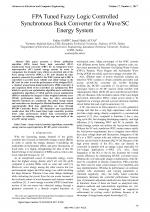| 1/2017 - 6 |
FPA Tuned Fuzzy Logic Controlled Synchronous Buck Converter for a Wave/SC Energy SystemSAHIN, E. |
| Extra paper information in |
| Click to see author's profile in |
| Download PDF |
Author keywords
fuzzy control, heuristic algorithms, renewable energy sources, supercapacitors, DC-DC power converters
References keywords
energy(30), power(20), fuzzy(17), systems(16), control(16), wave(15), system(11), logic(10), applications(10), conversion(9)
Blue keywords are present in both the references section and the paper title.
About this article
Date of Publication: 2017-02-28
Volume 17, Issue 1, Year 2017, On page(s): 39 - 48
ISSN: 1582-7445, e-ISSN: 1844-7600
Digital Object Identifier: 10.4316/AECE.2017.01006
Web of Science Accession Number: 000396335900006
SCOPUS ID: 85014151061
Abstract
This paper presents a flower pollination algorithm (FPA) tuned fuzzy logic controlled (FLC) synchronous buck converter (SBC) for an integrated wave/ supercapacitor (SC) hybrid energy system. In order to compensate the irregular wave effects on electrical side of the wave energy converter (WEC), a SC unit charged by solar panels is connected in parallel to the WEC system and a SBC is controlled to provide more reliable and stable voltage to the DC load. In order to test the performance of the designed FLC, a classical proportional-integral-derivative (PID) controller is also employed. Both of the controllers are optimized by FPA which is a pretty new optimization algorithm and a well-known optimization algorithm of which particle swarm optimization (PSO) to minimize the integral of time weighted absolute error (ITAE) performance index. Also, the other error-based objective functions are considered. The entire energy system and controllers are developed in Matlab/Simulink and realized experimentally. Real time applications are done through DS1104 Controller Board. The simulation and experimental results show that FPA tuned fuzzy logic controller provides lower value performance indices than conventional PID controller by reducing output voltage sags and swells of the wave/SC energy system. |
| References | | | Cited By |
Web of Science® Times Cited: 4 [View]
View record in Web of Science® [View]
View Related Records® [View]
Updated 2 weeks, 4 days ago
SCOPUS® Times Cited: 8
View record in SCOPUS® [Free preview]
View citations in SCOPUS® [Free preview]
[1] A novel control strategy for mode seamless switching of PV converter in DC microgrid based on double integral sliding mode control, Zhang, Qinjin, Zhuang, Xuzhou, Liu, Yancheng, Wang, Chuan, Guo, Hongzhi, ISA Transactions, ISSN 0019-0578, Issue , 2020.
Digital Object Identifier: 10.1016/j.isatra.2019.12.013 [CrossRef]
[2] Genetically Optimization of an Asymmetrical Fuzzy Logic Based Photovoltaic Maximum Power Point Tracking Controller, AL-GIZI, A., AL-CHLAIHAWI, S., LOUZAZNI, M., CRACIUNESCU, A., Advances in Electrical and Computer Engineering, ISSN 1582-7445, Issue 4, Volume 17, 2017.
Digital Object Identifier: 10.4316/AECE.2017.04009 [CrossRef] [Full text]
[3] Compatibility of objective functions with simplex algorithm for controller tuning of HVDC system, Rasool, Haaris, Rasool, Aazim, Ikram, Ataul Aziz, Rasool, Urfa, Jamil, Mohsin, Rasool, Haaziq, Ingeniería e Investigación, ISSN 2248-8723, Issue 3, Volume 39, 2020.
Digital Object Identifier: 10.15446/ing.investig.v39n3.70221 [CrossRef]
[4] Maximum power point tracking based upon expert systems in standalone photovoltaic system, Al-Chlaihawi, Sarab, Hassan, Ashwaq N., AL-KADHUM 2ND INTERNATIONAL CONFERENCE ON MODERN APPLICATIONS OF INFORMATION AND COMMUNICATION TECHNOLOGY, ISBN , Issue , 2023.
Digital Object Identifier: 10.1063/5.0120183 [CrossRef]
[5] Designing Dynamic Positioning System Based on H∞ Robust Recurrent Cerebellar Model Articulation Controller, Ta, V.P, Dang, X.K, Dong, V.H, Do, V.D, 2018 4th International Conference on Green Technology and Sustainable Development (GTSD), ISBN 978-1-5386-5126-1, 2018.
Digital Object Identifier: 10.1109/GTSD.2018.8595553 [CrossRef]
Disclaimer: All information displayed above was retrieved by using remote connections to respective databases. For the best user experience, we update all data by using background processes, and use caches in order to reduce the load on the servers we retrieve the information from. As we have no control on the availability of the database servers and sometimes the Internet connectivity may be affected, we do not guarantee the information is correct or complete. For the most accurate data, please always consult the database sites directly. Some external links require authentication or an institutional subscription.
Web of Science® is a registered trademark of Clarivate Analytics, Scopus® is a registered trademark of Elsevier B.V., other product names, company names, brand names, trademarks and logos are the property of their respective owners.
Faculty of Electrical Engineering and Computer Science
Stefan cel Mare University of Suceava, Romania
All rights reserved: Advances in Electrical and Computer Engineering is a registered trademark of the Stefan cel Mare University of Suceava. No part of this publication may be reproduced, stored in a retrieval system, photocopied, recorded or archived, without the written permission from the Editor. When authors submit their papers for publication, they agree that the copyright for their article be transferred to the Faculty of Electrical Engineering and Computer Science, Stefan cel Mare University of Suceava, Romania, if and only if the articles are accepted for publication. The copyright covers the exclusive rights to reproduce and distribute the article, including reprints and translations.
Permission for other use: The copyright owner's consent does not extend to copying for general distribution, for promotion, for creating new works, or for resale. Specific written permission must be obtained from the Editor for such copying. Direct linking to files hosted on this website is strictly prohibited.
Disclaimer: Whilst every effort is made by the publishers and editorial board to see that no inaccurate or misleading data, opinions or statements appear in this journal, they wish to make it clear that all information and opinions formulated in the articles, as well as linguistic accuracy, are the sole responsibility of the author.



